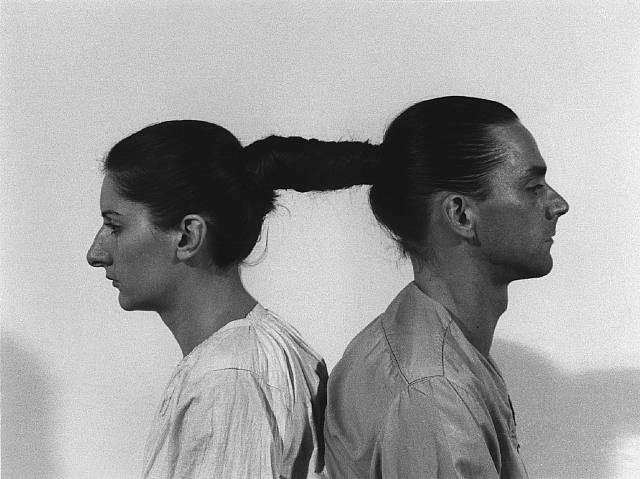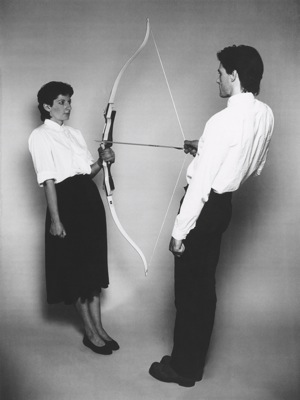
The Artist Is Present, with Doubt
In the late 1960s in Belgrade, Marina Abramović began thinking up rebellious unrealizable performances for public spaces, just as President Tito began thinking he would ease social restrictions by turning a former police station into a cultural center for student demonstrators to make art in. I turned 10 in 1970 and the dissonance of the times was (briefly) lost on me.

"Rest Energy". Performed in August 1980 for four minutes at ROSC80, National Gallery of Ireland. © 2010 Marina Abramović. Courtesy Marina Abramović and Sean Kelly Gallery/Artists Rights Society (ARS), New York
In 1975 in Amsterdam Marina met Ulay (on their shared birthday of Nov. 30). Then the couple, so personally and performatively joined they named their co-authorial-persona “The Self,” began traveling Europe in a Citroen van. When they stopped they struck up unrehearsed performances. Note the words, “art is easy” stenciled on the car windshield, facing in. Rest Energy. Performed in August 1980 for four minutes at ROSC80, National Gallery of Ireland.
While any tinny Citroen is to me redolent of my uncle Roger playing chicken at the wheel, seeing Marina and Ulays bus, on MoMas fourth floor, put me in mind of how there were at least two coincident Europes of 1968-1975; and continuing into the decade 1980(s) when I learned John Lennon was shot, in Paris, and came home. The zeitgeist collided Ronald Reagan and my learning to quip Benjamin H.D. Buchloh s hard point, Reagan inauguration year, that paintings were “luxury products of a fictitious high culture.”
Part then of what makes The Artist Is Present, Abramović s performance retrospective, and MoMas first time giving one, currency, is not just rarity. Yes, its a rare thing to see the grave museum re-booting the prismatic anarchic nature of performance on the street. So what. Its anxiety-producing, genital contact that you have to actually think about ahead of time, as experience of culture youve just paid money for. Yet the show with its real effects of human exertion moves you beyond your reserve of, “will I stay still for this?” or “Is all this noise querulous or imperiling?” To answer, “both” marks certainly the re-establishment of ambiguity between what you might say at a Vanessa Beecroft installation, chic mannequin, great body, and the mirror of consent asked by Abramović. For dont be fooled that youre not in la vie politique as you partake in witnessing two people relentlessly slapping each other for 40 minutes.
“Art is supposed to be beautiful artist is supposed to be beautiful,” indeed identifies to the beautiful face of Marina, ferocious hairbrush in and, acting as if shed scrape off her tresses. And even though there is not an option to take up knives or rub balms on the Pilates teachers and other volunteers who stand cold and naked in the doorway, the show keeps frontloading the problem of specific experiences-changed times.
Is that hairbrush us-specific?, meaning to me and the two cousins whose hair got combed just as rigorously, after a ride in the Deux Chevaux? Or is it group-specific to a post 1968 skirmish, a skirmish in public space, over how far any individual could go interpreting Marinas performance persona as she “(took) full responsibility for (her)self” with the presumption that so should you. A man back then in 74, for example, chose from the table the gun, put the gun into her hand, and moved her hand to her head.
Suffice to say there is a lot a lot of work in this show that was probably never meant to become 10 greatest hits under one roof. Our anthologizing times notwithstanding, one cannot re-create smells, the rancid bloodied cow bones that the artist washed and brushed off by her hand at a sweltering Venice Biennale. So the woman lying under cow bones just makes you wish she has a good chiropractor.
Marina, “The Artist Is Present,” herself will be at the museum for the duration of the art show, sitting some total 713 hours at a table that invites the periodic “audience-member” to take the seat opposite and stare back at her.
As to the video of the performances, I was most eager to see the Great Wall Walk (1988), that ended the first co-period of Marinas performance career with Ulay, and spelled a hiatus before she restarted in 1995. Maybe because I have always loved the Gertrude Stein line: “If we must part, let us go together”, the story is itself moving. Each of the artists had begun the Great Wall Walk at the opposite end, and walked nearly 1000 miles. To part. For Ever.
For a show that at one point made me weep, and realize I had needed to weep, it also raises questions of our uber-mediated times about how sexually canonical beautiful bodies are in art. Nobody I saw re-performing Marina came with a structural deformity. The artists beauty commanded a changing doorful of gawkers the one time I saw Marina perform live, in Santa Fe, sitting perfectly still in a chair set on a floor inlaid with ice blocks, as boa constrictors writhed on her body for the warmth. It seemed to me that in that art room she was ultimately as far apart as was humanly possible to get from the rest of us; from the “viewers.” Her growing cold was a matter, while obvious and unavoidable, of just as total doubt.
